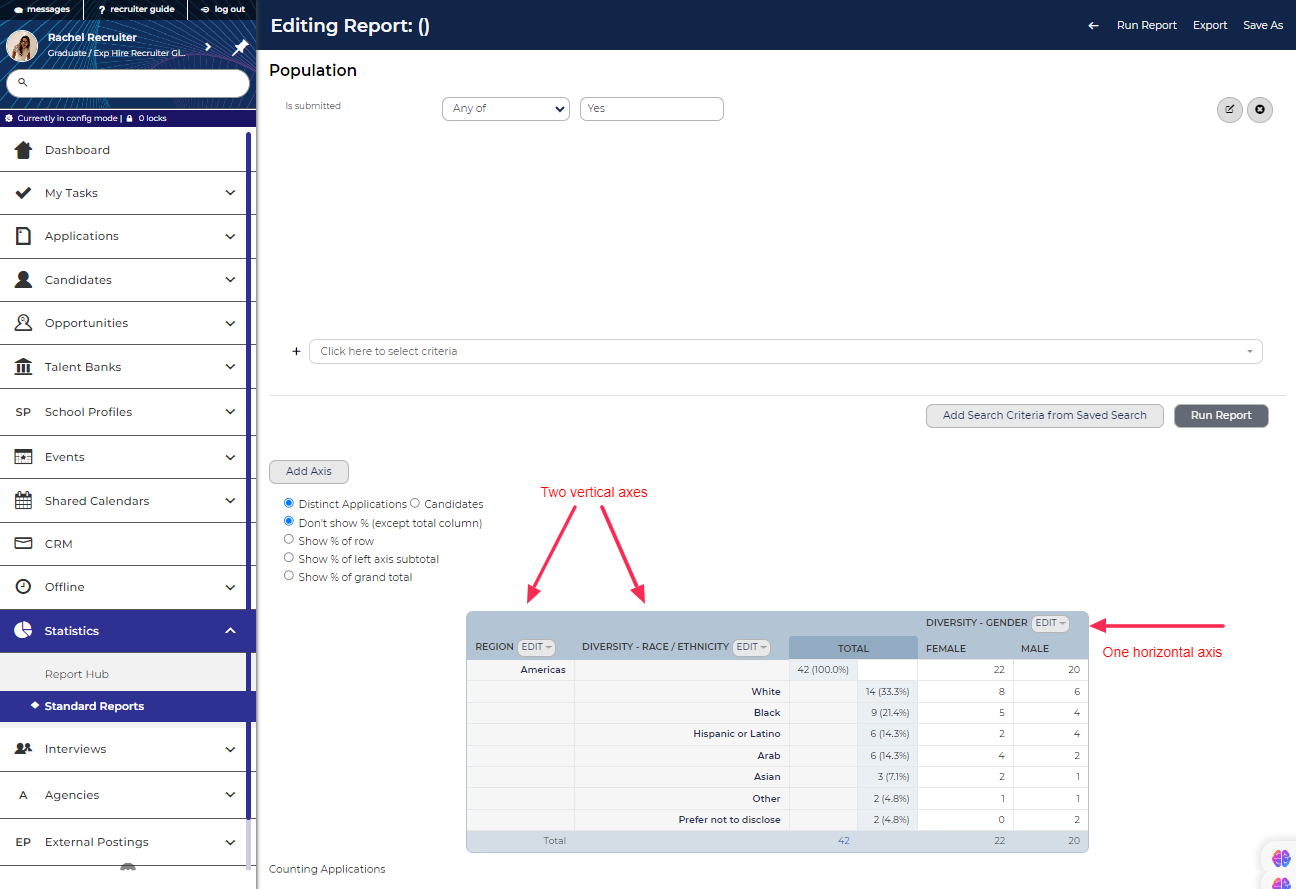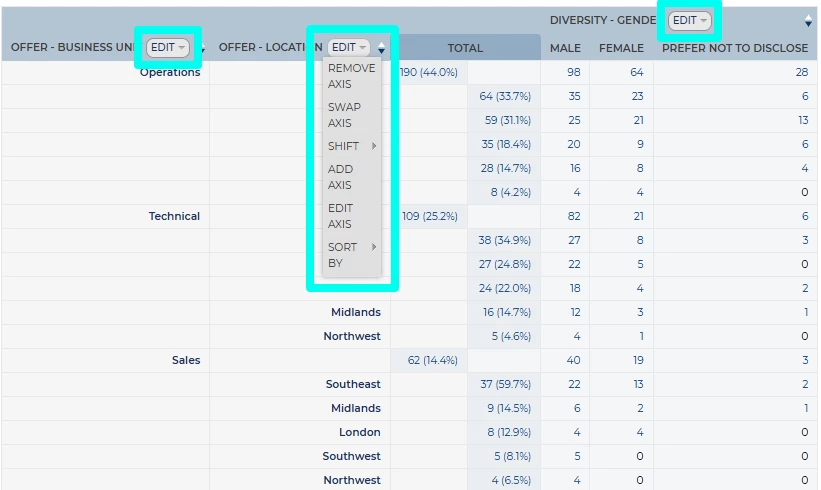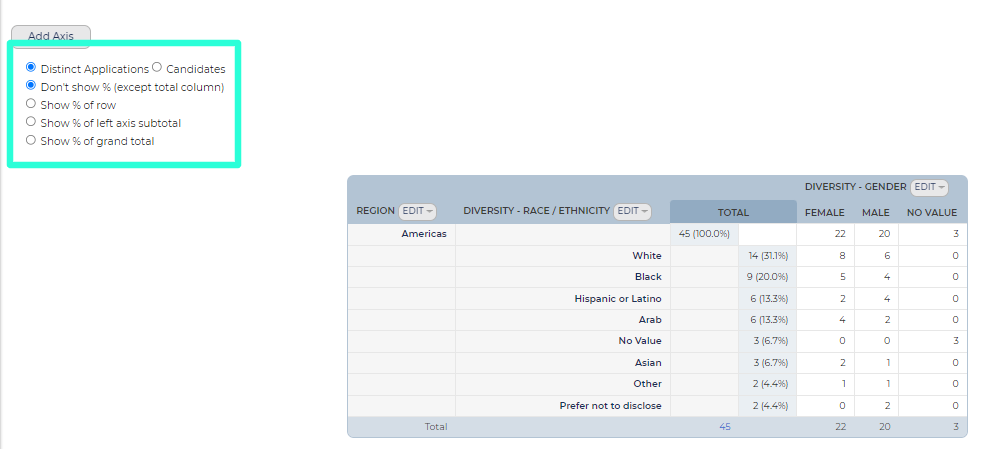You can use the Statistics tools to create a variety of different reports according to your preferences. The reports provide a summary of data on the system in a table format. Once you have created your report, you can amend the arrangement of the summarised data, save it for future use, or export it to a spreadsheet.
TYPES OF DATA THAT CAN BE REPORTED ON
You can report on any non-free text field on your system, providing it has been added to the Data Dictionary. If there is a field you'd like to report on that is not available, contact a super user.
There are three main types of report that you can create:
- Application - This type of report counts the number of applications (e.g. the number of applications from each university).
- Opportunity/Vacancy - This type of report counts the number of vacancies (e.g. the number of vacancies created for each location).
- Event - This type of report counts the number of events (e.g. the number of events created for each location).
Application
When creating a report on application numbers, you can report on the following types of fields:
- Application items - Data stored against an application (e.g. application status).
- Application form fields - Information provided by candidates when they submit their application (e.g. equal opportunities info).
- Opportunity / Vacancy items - Essential information stored in the opportunity details tab of the opportunity summary page (e.g. vacancy title).
- Opportunity / Vacancy description fields - Information stored in the opportunity description tab of the opportunity summary page (e.g. you may want to report on how many applications were made to each location).
- Flags - Information flagged against applications on the Flags recruiter form.
Opportunity / Vacancy and Events
When creating a report on vacancy or events numbers, you can report on the following types of fields:
- Opportunity items - Essential information stored in the details tab of the opportunity summary page (e.g. title).
- Opportunity description fields - Information stored in the description tab of the opportunity summary page (e.g. you may want to report on how many opportunities have been created for each location).
REPORT FEATURES
- Choose the target Population for reporting:
- You can report on all applications that you have access to or filter the population.
- You can filter using any field that has been added to the Data Dictionary, including free-text fields.
- Multiple axes for comparative analysis:
- You can add multiple axes to your report for comparing various fields.
- Example: Compare 'source of application' to 'application status'.
- You can add multiple vertical axes and one horizontal axis for versatile reporting.
- Click-through to the detail:
- The numbers in the 'Total' columns are clickable links.
- By clicking the number, you can access the list of applications or vacancies.
- Please note that if your profile restricts access to the data, the link will not be activated (e.g., certain profiles may not have click-through access when viewing reports on equal opportunities data).

CREATING A NEW REPORT
Switch your account to show archived data
- If you're reporting on historical data, including archived data is essential.
- It's advisable to switch your account settings to show archived data before initiating the report creation process.
- Changing your account settings to show archived data during the report creation process will result in the loss of any unsaved changes.
Initiate the process and select your Report Type
- In the left-hand menu, navigate to Statistics > Standard Reports.
- In the Report List Action Toolbar, click Create Report.
- A pop-box will appear, where you need select the type of report that you would like to create:
- Application - This type of report counts the number of applications (e.g. the number of applications from each university).
- Opportunity / Vacancy - This type of report counts the number of opportunities (e.g. the number of opportunities created in each location).
- Event - This type of report counts the number of events (e.g. the number of events created in each location).
- Click Create Report.
- You will then be taken to a page where you can select the population and axes for your report.
Select the target Population for reporting
If you do not specify a population, your report will include every candidate or opportunity accessible to you.
To focus on specific criteria you can filter the population. You can use any field from the Data Dictionary, including free-text fields.
- Add filter criteria using the select criteria search bar:
- The population selection process mirrors the functionality used for advanced searches.
- Click the search box labelled 'Click here to select criteria' and select the first field you would like to use for filtering.
- You will then be asked to select the value that is required for this field.
- Repeat the process until all the required filter fields have been added.
- Add filter criteria using a Saved Search:
- Employ a previously saved search to define your population effortlessly.
- Click the 'Add Search Criteria from a Saved Search' button.
- You will be able to select from all public saved searches and private saved searches (i.e. ones you have created) that match the Report Type.
- Once the saved search has been selected, you can add additional criteria using the 'Click here to select criteria' search box.
- Modifying Search Criteria:
- After adding search criteria, you can amend them as you would with any saved search by clicking the edit or remove links for the criteria you wish to adjust.
Reports include unsubmitted applications by default:
- If your account permits access to unsubmitted applications, they will be included by default, potentially affecting statistics.
- To address this, filter out unsubmitted applications by adding the criteria "Is Submitted" field equals "Yes" or adding "Submission Date" field "Is Not Blank."
Common fields for defining the Population:
When creating reports, the following fields are frequently used to filter the population. Please note that they may be named differently on your system. If you encounter any difficulty finding a specific field, reach out to a super user for assistance.
- Submission Date: Use this field to filter the population based on applications submitted during a specific time period.
- Opportunity / Event Title (List): Select the opportunities you want to include in the report from a list. Note: This field might also be labelled as "Vacancy / Event Title (Search)."
- Recruitment Year: If your system involves graduate recruitment, consider filtering based on the "Recruitment Year" opportunity field. It might also be referred to as "Recruiting Season."
Add axes
The axes are the fields that define the data you would like to display and summarise in your report.
If you want to compare more than one field, you can add multiple axes. However, axes can only be added one at a time.
- Click on the Add Axis button underneath the Population.
- A pop-up box will open where you can select the field that you would like to use as an axis. Use the soft search at the top of the list to narrow down the list.
- Once you have selected the field, click Add Axis.
- The page will now reload and your selected axis will be summarised in the report.
- You may want to compare more than one item/field in your report. For example, you might want to compare University to Application Status. To add additional axes, follow the same process. Each new axis will be added to the left of the existing axes.
Consider readability when adding multiple axes:
While there's no strict limit on the number of axes you can incorporate, it's crucial to consider the readability of your comparison reports. Adding too many axes can make the report challenging to interpret.
- Diversity Fields Example:
- If you need to report on various diversity fields, it's advisable not to include them all as axes in a single report.
- Instead, create separate reports for each diversity field to enhance clarity and ease of interpretation.
- To streamline presentation, leverage the Report hub tool to consolidate these separate reports onto a single page.
Steps to take if you can't find the field you want to use in a report
Any fields you wish to use to filter the population or add as axes must have been added to the Data Dictionary.
If you can't find the specific item you are looking for, keep in mind that the internal name may differ from the question displayed on the form.
Try searching using a relevant keyword instead of the entire question. If you are still unable to locate the desired fields, please reach out to a super user for assistance. They may be able to identify the internal name of the field or add it to the Data Dictionary.
Rearrange your report
You can use the Edit dropdown in the column heading of each axes to rearrange your report.
You have the following options for each axis:
- Remove Axis - Click this to remove that axis from the report.
- Swap Axis - Click this to change the axis from a vertical to a horizontal axis, and vica versa. If you already have a horizontal axis in your report, the axes will swap positions.
- Shift Right/Left - This button will appear if you have more than one vertical axis in your report. Click this to move your column to the left or to the right.
- Add Axis - This allows you to add additional axes to your report.
- Edit Axis - Use this option to set a Minimum Percentage Threshold or adjust how dates are grouped on the axis:
- Minimum Percentage Threshold: Filters results to include only values that meet or exceed the specified proportion of the total. Example: If reporting on applications by university, setting a 1% threshold would exclude universities chosen by fewer than 1% of candidates.
- Show dates grouped by: Controls how date fields are displayed on the axis. By default, dates are grouped by day (e.g., number of applications submitted each day). You can instead group by month, quarter, or year to view trends over longer periods.
- Sort by - By default, each axis will be sorted by the total column, in descending order. Use this to switch to sorting in ascending order, in alphanumeric order, or by the order of the 'Lookup List' (e.g. dropdown list order).

REPORTS USE SYSTEM TIME, NOT USER'S TIME
If your system is used across multiple time zones, it's useful to note the distinction in how time zones are managed between reports and application/opportunity history.
- Reports utilise system time:
- When using a date field to filter the data or add an axis in a report, the system's default time zone is applied.
- This ensures consistent data presentation, irrespective of the report creator's location or time zone.
- If you are not sure what the default time zone is for your system, check with a super user.
- Application/Opportunity history reflects user's time zone:
- In contrast, application and opportunity history records display times in the user's 'Time Zone' setting within their account.
- This ensures accurate time stamps that align with the user's perspective and time zone.
SWITCHING YOUR REPORT TO COUNT CANDIDATES INSTEAD OF APPLICATIONS
When you create an application report, it defaults to counting the number of distinct applications.
By default, if a candidate applies to multiple opportunities, they will be counted separately in the report for each distinct application.
If you want each candidate to be counted only once, regardless of the number of applications they've submitted, you can switch to reporting on candidates.
Steps to switch to candidate reporting:
- Find the Distinct Applications and Candidates radio buttons beneath the 'Add Axis' button.
- To ensure each candidate is counted once in the report, regardless of their application count, select the Candidates option.
- The report automatically refreshes upon selecting a different radio button, and you can adjust this setting at any time.
Applications are still counted twice if answers are different:
- Be mindful that if a candidate provides different answers for the field you're reporting on in multiple applications, they will still be counted separately.

CREATING STATUS OF APPLICATION/OPPORTUNITY SUMMARY REPORTS
You can create a report that summarises the status of applications or the status of vacancies (if your system uses a vacancy process flow).
These reports are very useful if you want to see an overview of what is currently happening or if you want to find out what types of applications are successful.
There are two types of status reports:
- Snapshot - This report will summarise how many applications/opportunities are currently in each status.
- Cumulative - This report will summarise how many applications/opportunities have ever, at some point in time, been in each status.
To create a report on status:
- Add an axis as usual.
- Locate the Application Status or Vacancy Status field and click Add Axis (these fields may have a slightly different name on your system).
- On the next page, check the Cumulative box if you would like to create a cumulative report and then click Submit.
SAVING YOUR REPORT
If you have created a report that you would like to re-run in the future, you can save it to the system.
You will then be able to access it from the 'View All Reports' link under the Statistics section of the left-hand menu.
To save your report:
- In the Statistics Action Toolbar, click Save As.
- You will then be asked to fill in the following information about your report:
- Title* - Give your report a title that succinctly explains what is shown in the report. It's a good idea to include details of the population and axes (e.g. 2023 UK applications: Status vs Gender).
- Description - You can enter a more detailed description of what the report summarises.
- Is Public - If the checkbox is selected, your report becomes accessible to all users. However, be aware:
- Your profile settings might limit your ability to create public reports.
- Individual access to private reports can be granted, as detailed in the section below.
- Private reports can be used in Report Hub but they will not load when the Report Hub is viewed by other users.
- Category* - Confirm if the report is an Opportunity, Application or Candidate report.
- Saved Search Name:
- If you've configured specific population criteria that you plan to use in other reports, enter a name for the population in this field.
- The criteria will be saved as a "Saved Search" for future reference.
- Leave this field blank if you don't intend to reuse these criteria in other reports.
- Click Submit to save your report.
- If you re-run this report in the future and change the axes or population, for example, click Save from the Action Toolbar to overwrite the report and save the changes or Save As if you want to keep the original report and save the changes as a new report.
GIVING COLLEAGUES ACCESS TO A PRIVATE REPORT
To give individual users access to your private report, follow these steps:
- From the left-hand menu, go to Statistics > Standard Reports.
- You will be presented with the full list of global saved reports, including any private reports you've created, or those shared with you by your colleagues.
- Double click on the report that you would like to share with a colleague.
- Click on the Edit Report button in the Report Toolbar.
- Once the page has reloaded, click on Report Properties in the Report Toolbar.
- In the Report Properties menu, navigate to the User Access tab.
- In the Grant User Access field, select the user you want to allow access to the report. You can search by first name or last name. You cannot search by full name.
- Click the Submit button at the bottom of the box.
- Click Save in the Report Toolbar.
- The report will now be available to the user when they navigate to Statistics > Standard Reports.
ACCESSING A SAVED REPORT
- From the left-hand menu, go to Statistics > Standard Reports.
- You will be presented with the full list of global saved reports, including any private reports you've created, or those shared with you by your colleagues.
- Double click on the report that you would like to run. You will then be presented with the report in view mode.
EXPORTING YOUR REPORT INTO A SPREADSHEET
Once you have created a report, you can export it into a spreadsheet. You can then send the report to a colleague who does not have access to the system or use the spreadsheet functionalities to convert the data into a graph.
To export your report into a spreadsheet, click Export from the Statistics Action Toolbar.
ADDING YOUR REPORTS TO YOUR DASHBOARD
You can add your reports as widgets to your dashboard so that you have instant access as soon as you login.
- If you are customising your dashboard for the first time, navigate to Dashboard > Customise Dashboard from your left-hand menu.
- Navigate to the dashboard tab where you want to add the report.
- Click the dropdown in the tab heading and choose Add Widget.
- In the Choose Dashboard Widget field, select Statistics Report.
- In the Statistics Report field, choose the specific report you want to add.
- Click Save.
You can only add one report per tab:
- You are limited to adding one report per tab to prevent potential delays in page loading.
AGGREGATING REPORTS WITH CHARTS USING THE REPORT HUB
After crafting a set of reports, leverage the Report hub tool to seamlessly present them in a single document with charts.
You can schedule Report Hub reports to be sent regularly to stakeholders, ensuring timely updates.





